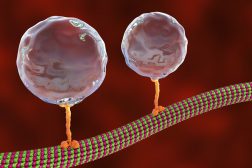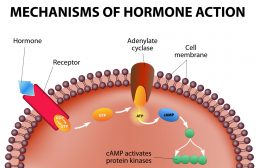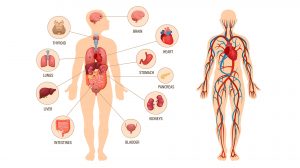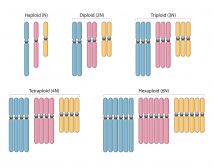Definition
noun, plural: granulocytes
A leukocyte characterized by the presence of numerous staining granules in the cytoplasm when observed by light microscopy
Supplement
White blood cells (also called leukocytes) are cells of the immune system. They are called white due to the lack of the hemoglobin pigment, which is present in red blood cells. Similar to red blood cells though, the white blood cells also came from a hematopoietic stem cell (hemocytoblast). The hemocytoblast gives rise to progenitor cells of both the myeloid series and the lymphoid series. Granulocytes are white blood cells derived from the common myeloid progenitor cell. In the granulocytic series, the developmental stages are as follows: hemocytoblast → common myeloid progenitor (or CFU-GEMM) → CFU-GM → CFU-G → myeloblast → promyelocyte → myelocyte → metamyelocyte → band cell → granulocyte (particularly, polymorphonuclear leukocytes).
Granulocytes have different cytoplasmic granules as opposed to agranulocytes that seem to lack them. The cytoplasmic granules can be observed through staining technique and light microscopy. Examples of granulocytes are polymorphonuclear leukocytes and mast cells. In humans, the polymorphonuclear leucocytes are subdivided into eosinophils, basophils and neutrophils (according to the staining properties of the granules using a Romanovsky type stain).
The mast cells are considered as a type of granulocyte for having cytoplasmic granules. However, unlike the polymorphonuclear leukocytes derived from the granulocytic lineage, the mast cells arise from the common myeloid progenitor cell without going through the various developmental stages in the granulocytic series.
Hematopoiesis producing granulocytes, particularly polymophonuclear leukocytes, is referred to as granulopoiesis.
Synonym(s):
- multinuclear leukocyte
- granular leukocyte
Compare:
See also:
- metamyelocyte
- hematopoiesis
- granulopoiesis
- band cell
- leukocyte
- polymorphonuclear leukocyte
- mast cell
Related term(s):
Related form(s):
- granulocytic (adjective, of, pertaining to, or relating to a granulocyte)
- Granulocytic leukaemia







